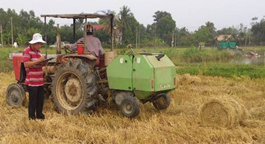Nguyen Thanh Nghi1, Nguyen Duc Canh1, Hau Duc Hoa1, Nguyen Van Hung2 and Martin Gummert2
1. CenterforAgriculturalEnergy andMachinery,NongLamUniversity,HoChiMinhCity700000,Vietnam
2. CropandEnvironmentalScienceDivision,InternationalRiceResearchInstitute,MetroManila1301,Philippines
Abstract: Rice straw is a rice by-product, which is currently mostly wasted in Vietnam, in particular in the Mekong delta. At present,the cost of straw gathering is increasing because of the increased use of combine harvesters. High labor cost and lack of labor makesmanual collection unfeasible. Farmers therefore often just burn it, which causes pollution, increased greenhouse gas emissions andloss of opportunities to value add. An economic and environmental evaluation and technical field testing of a straw baler with 4ha/day capacity was there fore conducted in LongAn province. During the field testing data on the gathering capacity, fuel consumption, labor requirement and other costitems were collected. The test results showed that the baling costis US$19.0 pert on of rice straw, the pay-back period of 2.1 years and the internal rate of return of 38%. In addition to the baling cost, the transportation cost varies from US$24 for a distance of 100 km to US$32 for 150 km. The benefits of the machine are not only economical but also includethe reductionof field burning.
Keywords: Rice straw gathering, technical and economice valuation,environmental benefits.
Số lần xem trang: 3756


